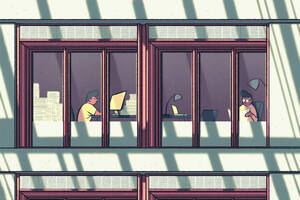Innovation Organizations Dec 1, 2015
Does Your Company Need a “MacGyver”?
A scrappy insider might be the best innovator for your business.

Yevgenia Nayberg
The 1980s TV action hero Angus MacGyver was known for getting himself out of tight situations without an extensive array of weapons, brute strength, or high-tech gadgetry. Rather, he succeeded by relying on his knowledge of physical sciences and his ability to employ whatever he had at his disposal—a book of matches, a stick of chewing gum, a shoelace—to thwart threats posed by international criminals.
What makes MacGyver so compelling is the everyday nature of his pluck. Rather than try to take down an entire enterprise with one elaborate operation, he tweaks a little here and a little there—and those incremental changes have a transformational effect over time.
For companies interested in innovating, the question of how best to bring change is a perennial one: Do you bring in consultants to analyze the situation from a fresh perspective, or do you put the responsibility on an internal agent to solve problems? Jean Egmon, a clinical professor of management at the Kellogg School, sees great value in empowering “MacGyvers” to act as intrapreneurs.
As trusted sources who leverage resources and networks across the company to find simple, often small-bore solutions, “intrapreneurs are not only people who create new businesses within a business, but who create new ways of doing business within a business,” she says. “A MacGyver’s using pieces of things to create a new whole.”
So how can business leaders identify and empower their companies’ MacGyvers?
Find a Trusted Insider
Egmon describes MacGyvers as possessing a deep understanding of the business inside and out, making them highly attuned to both the growth potential and the cultural tone of the company. Their insider status gives them institutional knowledge. It also helps them earn the trust of stakeholders across the company who may otherwise be wary of change.
“MacGyver is a trusted, known source,” Egmon says. “You recognize MacGyver in your hall. They’re your friend; they’re your colleague. Culturally, MacGyver fits—and yet there’s something a little different about him or her that is going to nudge the business in a new way.”
“There’s intelligence, there’s talent, there’s technology, there are ideas, there’s market data. A MacGyver knows that it’s there, and can pull it together in interesting, creative ways to make something new.”
One of Egmon’s favorite examples of a corporate MacGyver is Joe Tallarico, global director of business operations at Unilever, who has applied the skills he learned as a kid from his father, while working in his family grocery to solve some of the company’s most pressing problems.
When Unilever shifted its sales strategy from a focus on pure volume to a focus on profitability volume, it turned to Tallarico. Tallarico had insider knowledge: he had started as a sales representative at the company, going store to store making sure its products were on the shelf, displayed and priced properly. “That was the foundation of really understanding the business,” he says, “where you really saw your product getting into consumers’ hands. From there you learn everything.”
Tallarico realized that standardizing the promotion-planning process, adding technology to allow sales to see the profitability, and changing the incentive program triggered the change that would help the operation grow leaner and more responsive. Convincing people that they should change was not easy—but as an insider, Tallarico had not just the insights but the credibility.
Give MacGyver a Mandate to Connect Dots
Once potential MacGyvers have been identified, they must be empowered to continue cultivating relationships across the enterprise. Intrapreneurs who belong to multiple networks can get a sense of the capabilities and resources that might otherwise be stuck in silos within the company, says Egmon.
“There’s intelligence, there’s talent, there’s technology, there are ideas, there’s market data,” she says. “A MacGyver knows that it’s there, and can pull it together in interesting, creative ways to make something new.”
Having a wide network provides an intrapreneur with a broad sense of what is possible within a company and what works in other parts of the organization. MacGyvers also are very attuned to the external environment, often across industries. This puts the intrapreneur in a fantastic position to question established practices.
“It’s natural for people and organizations to get into a routine.” Tallarico says. “I always ask two questions: Is what we are doing because the customers need it in the marketplace, or is it because we’ve just always done it that way? And, if you were starting a brand new company, would we do it that way?”
An enterprise-wide scope also allows intrapreneurs to incrementally tweak existing processes, standardize those processes, and then spin them off into other parts of the organization—what Egmon calls “sweeping knowledge off the shop floor.” They can then magnify these wins by identifying knock-on effects.
Keep MacGyver Moving
What happens after an innovation project ends?
“When an organization is willing to take on the challenge of a project, they must be willing to change—willing to come up with new ideas— and having a good change management plan on hand to sustain that change that makes a company that much stronger,” says Tallarico. One way to make an innovation stick is to have a MacGyver on hand to periodically check back in and course correct.
But more than anything, MacGyvers need to continue their trek around the organization, acting as evangelists for innovation. In doing so, they become repositories of sorts for new ideas—unconventional, even weird ideas. People who would otherwise not know where to send these ideas now have a person to go to, and worthy innovations that would never have otherwise come to fruition can find their champions.
“If leaders can recognize those MacGyvers in the company, give them permission to do what they do, and keep them moving,” says Egmon, “that starts to create a groundswell of innovation in the culture.”


